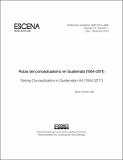Mostrar el registro sencillo del ítem
Rutas del conceptualismo en Guatemala (1954-2011)
| dc.creator | Véliz, María Victoria | |
| dc.date.accessioned | 2020-01-16T14:48:40Z | |
| dc.date.available | 2020-01-16T14:48:40Z | |
| dc.date.issued | 2019 | |
| dc.identifier.citation | https://revistas.ucr.ac.cr/index.php/escena/article/view/37823 | |
| dc.identifier.issn | 2215-4906 | |
| dc.identifier.uri | https://hdl.handle.net/10669/80305 | |
| dc.description.abstract | Este ensayo explora las relaciones entre los conceptos arte político y arte como estrategia de acción política (Camnitzer, 2008), junto a los de poder sobre y poder hacer (Holloway, 2002) en Guatemala (1954-2011). Dentro de tal marco, este trabajo ubica las prácticas conceptualistas del país, mediadas por la guerra (1960-1996) y el exilio. Al tiempo que estudia el papel de Costa Rica como refugio de exiliados y como epicentro de las relaciones artísticas centroamericanas. El conceptualismo guatemalteco y el centroamericano, en general, es bastante desconocido aún, dada la falta de archivos, documentos e investigaciones que den cuentan de este período. Pese a ello, ha sido una práctica viva durante una buena parte del siglo XXI, debido a la persistencia de las condiciones sociales que le dieron origen y a las redes artísticas transnacionales que la validan. Al menos, hasta las elecciones del 2011, en Guatemala, el conceptualismo era parte, por igual, del lenguaje político y artístico. | es_ES |
| dc.description.abstract | This essay explores the relationship between concepts such as political art and art as a strategy of political action (Camnitzer, 2008), as well as power over and power to do (Holloway, 2002) in Guatemala (1954-2011). Within this framework, this work situates the conceptualist practices in the country, also mediated by war (1960-1996) and exile; and studies the role of Costa Rica as both a haven for exiles and epicenter of Central American artistic relations. Guatemalan conceptualism, and Central American conceptualism in general, is still relatively unknown given the lack of archives, documentation and research that take this period into account. Nevertheless, conceptualist art practices stayed vibrant well into the 21st century due to the persistence of the original social conditions and the artistic transnational networks that validate them. At least until the Guatemala elections of 2011, in, conceptualism was as much part of the political as the artistic language. | es_ES |
| dc.language.iso | es | es_ES |
| dc.source | ESCENA. Revista de las artes, vol.79(1), pp.75-98 | es_ES |
| dc.subject | Conceptualismo | es_ES |
| dc.subject | Poder sobre | es_ES |
| dc.subject | Poder hacer | es_ES |
| dc.subject | Arte político | es_ES |
| dc.subject | Acción política | es_ES |
| dc.subject | Conceptualism | es_ES |
| dc.subject | Power-over | es_ES |
| dc.subject | Power-to-do | es_ES |
| dc.subject | Political art | es_ES |
| dc.subject | Art | es_ES |
| dc.subject | Political action | es_ES |
| dc.title | Rutas del conceptualismo en Guatemala (1954-2011) | es_ES |
| dc.title.alternative | Tracing Conceptualism in Guatemalan Art (1954-2011) | es_ES |
| dc.type | artículo original | |
| dc.identifier.doi | 10.15517/ES.V79I1.37823 |
Ficheros en el ítem
Este ítem aparece en la(s) siguiente(s) colección(ones)
-
Escena 79(1) [12]


